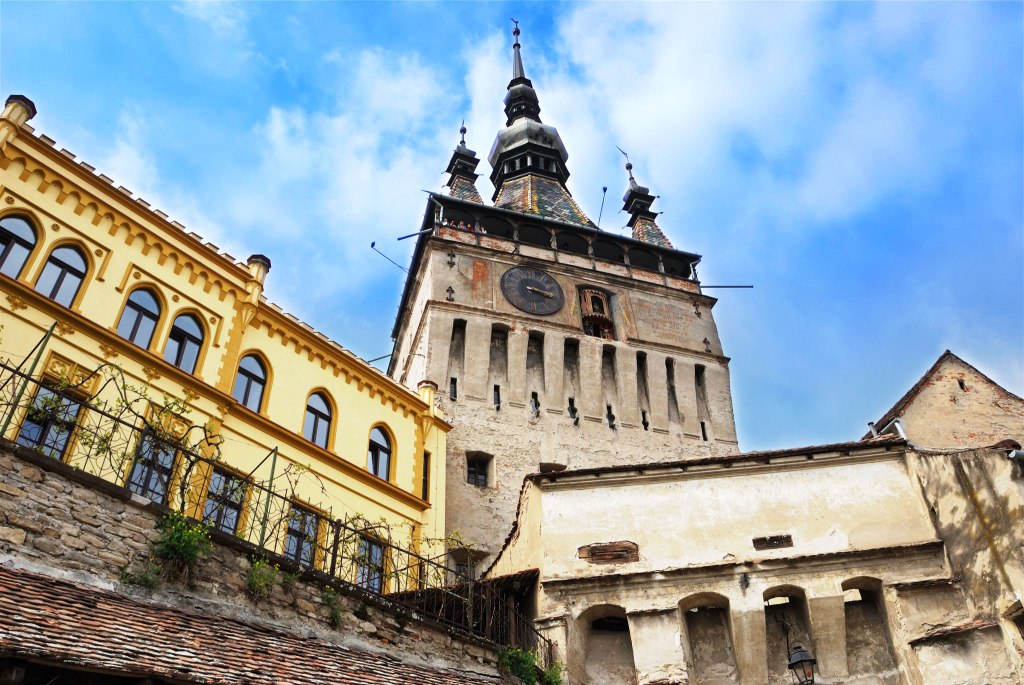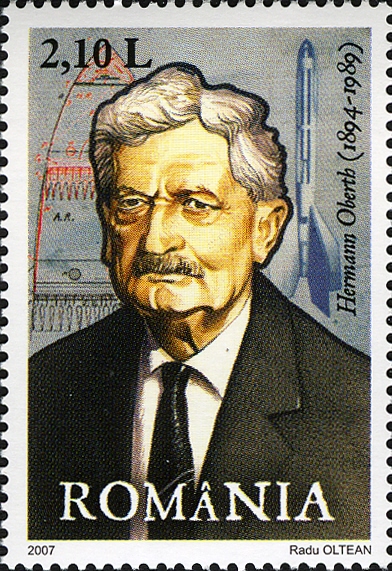The same question arises when I try to put together the patterns of my life. Is life a series of random events and bizarre coincidences, or does life follow a discernible pattern called destiny? In other words, do things just happen or are they meant to be? I would like to think the latter, but I realize that our minds discern patterns to make sense of an insanely complex and chaotic world. Whether it is true or not, I prefer to keep on believing that most things in life are meant to be. Coincidences are connections, and life’s puzzles will reveal patterns if pursued long enough. This was the case when I began to research Transylvania’s rocket man, Herman Oberth. A chance discovery a decade earlier had settled somewhere deep in my subconscious. Little did I know that Oberth was not only lurking in my memory, but also on a nearby bookshelf.

Looking up – Sighisoara Clock Tower rises to the occasion
Clocking In – Scientific Methods
I heard curiosity rather than destiny calling when I began to research and write about Herman Oberth, a Transylvanian Saxon who through imagination, intelligence, and self-belief became the father of German rocketry. Oberth was very different from the other Transylvanians that have interested me. He was not a prince or peasant, aristocrat or artist. Oberth was a brilliant scientist. This was foreign territory for me. I am not scientifically inclined and have very little interest in space travel, which was one of Oberth’s specialties. He wrote several books which I could never read because the concepts are (literally) over my head. And yet, Oberth was one of those people I could not get out of my mind. Our only meeting did not last more than a few minutes and was so memorable that I am unlikely to ever forget it.
Oberth died twenty-five years before we met, but I doubt he could have made as much of an impression in the flesh as he did that spring day in Sighisoara. The rocket man’s life and work were the subject of a small exhibit in the 13th century Clock Tower. History went from the medieval to the moon for anyone who huffed and puffed their way up very steep stairs. If I remember correctly, the exhibit was located between flights of stairs. The Oberth exhibit was there to greet anyone out of breath. I imagine that many people have the same incredulous reaction as me. Surely this could not be a serious attempt at engaging visitors. The Clock Tower does a fine job of that on its own. As does Sighisoara’s immaculately preserved Old Town. I went there to see it and search for Vlad Tepes (Vlad The Impaler’s) birthplace. I achieved both of those goals. The unexpected byproduct was a lasting acquaintance with Oberth, one that would infrequently keep coming back to me until a decade later I finally acted on my curiosity to find out more about him.
Space age – Romania stamp for Hermann Oberth (Credit: Post of Romania)
Unsolved Mystery – An Historical Anomaly
A cursory search of the internet revealed that Oberth is a legend in the history of rocketry. He lived a long life with most of it spent in Germany. He also lived in the United States where he worked on rocket programs for the military. The most obscure parts of Oberth’s life are his first thirty years, most of which were spent in Transylvania. His Transylvanian Saxon roots in the region do not seem to fit a man who imagined such things as moon cars. The Saxons were good at trade, constructing fortified churches, and keeping to themselves. Nothing could be further from the space age than such an insular community. Perhaps Oberth’s imagination was stimulated as a reaction against century old traditions. He wanted to visit new frontiers, though he grew up in a very old one.
I can think of a lot of things Transylvania stimulates such as a love of nature, folk culture, and the simple pleasures of life. Rockets shooting across the sky and manned space flight would be the furthest thing from my mind. Obviously, Hermann Obert had other ideas. The kind that could change the world though he lived in one that had changed very little since the Middle Ages. Obert’s imagination was stimulated by a couple of novels by Jules Verne. There might have been something about Transylvania that spurred his scientific creativity as well. Whatever that was we will probably never know. The Oberth exhibition in the Clock Tower was not going to solve that mystery. Nevertheless, if not for the time Oberth spent in Sighisoara, mostly during World War I, he might never have achieved many of his dreams, which not coincidentally turned into nightmares for British civilians who were on the receiving ends of V-2 rockets he helped develop during World War II. All that was in the future. In Sighisoara, Oberth was already looking towards it.

Personal history – Danubia by Simon Winder
Taking Notice – Strokes of Genius
Getting transferred from the death and destruction of the Eastern Front to relatively quiet Sighisoara led Oberth to scientific strokes of genius with liquid fueled rocketry and weightlessness. His career began to take flight in the small and sleepy Transylvanian city. I doubt the Sighisoara History Museum, which administers the Clock Tower, would have put together an exhibit on Transylvania’s rocket man if several of his intellectual breakthroughs had not occurred while Oberth was stationed in the city. Thank goodness they did. Otherwise, I would never have known Oberth ever existed.
When I first saw the exhibit, I questioned why it was there. Once I learned of Oberth’s time in Sighisoara, I then questioned why the exhibit was in the Clock Tower. The most probable answer was that the hordes of German tourists who come to Sighisoara love to learn about how one of their ethnic kin has a connection there. I assumed that I was one of the few English speakers who showed the slightest bit of interest in the Oberth exhibit. Foreigners who visited the Clock Tower probably glanced at the exhibit and never gave it a second thought. My interest in Oberth was only because I led tours of a former nuclear missile site at the time. Who else could possibly have been intrigued by the exhibit? Simon Winder, the author of Danubia: A Personal History of Habsburg Europe, was who.
Click here for: Shelf Life – A Fellow Traveler In Sighisoara (Rendezvous With An Obscure Destiny #72)


i must try to get a copy of Winder’s book. looks fascinating.
I have just bought it1
It is so good!!!